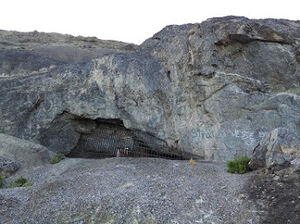Holocene Climate
Holocene Climate is the Earth weather for the recent 10,000 to 12,000 years of the Earth's history, the time since the end of the last major glacial advance
In addition to the general global warming that began 10000 BC, there have been small-scale climate shifts -- notably the Little Ice Age between about 1200 and 1700 A.D. The chief climate trend of the Holocene has been a warming period interspersed with minor Ice ages. However the Holocene itself can be regarded as a warming period of the previous Ice Age that began in after the Eemian (the the last interglacial prior to the most recent major ice age that lasted until the beginning of the Holocene).
Another notable climate shift in historic time is the Roman Warm Period or Roman Climate Optimum, which exhibited temperature and weather patterns remarkably similar to the prior decades (1970-2021). (Wang et al, 2013) That was an era where human civilization flourished, crops abounded and disease was at a low point. In fact, Wang points out, that while the climate was totally of natural causes, it was very similar to that of the present time. The Roman Climate Optimum endured from about 250 BC to 400 AD, roughly spanning the entirety of the height of the Roman Empire.
Another name for the Holocene that is sometimes used is the Anthropocene, the Age of Man. This term may be somewhat misleading: humans of our own subspecies, Homo sapiens sapiens, had appeared and dispersed over most of the world well before the start of the Holocene. Yet the Holocene has witnessed the human population explosion and all of humanity's recorded history and the rise and fall of many of its civilizations.
Humanity has greatly influenced the Holocene environment; while all organisms influence their environments to some degree, none have changed the globe as much, or as rapidly, as our species is doing. Many scientists argue that human activity is at least partially responsible for global warming, an increase in mean global temperatures; however, most atmospheric scientists assert the fundamental contributions of man to modern climate change began at several millennia ago, with broad scale deforestation and resultant carbon releases to the atmosphere. This point is further amplified by a 2021 study illustrating that solar cycles are much more important than earlier thought relative to greenhouse gas effects. (Mazza & Canuto, 2021)
Habitat destruction, habitat fragmentation, pollution, and other factors are causing an ongoing mass extinction of plant and animal species; according to some projections, 20% of all plant and animal species on Earth will become extinct within the next 25 years. Practically all of these impacts can be attributed to man's direct impacts of habitat destruction, deforestation and water pollution, pesticide and herbicide use, increased toxins from manufacture of solar panels and electric batteries, and virtually any to variation in climate.
Yet the Holocene has also seen the great development of human knowledge and technology, which can be used -- and are being used -- to understand the changes that are occurring, to predict their effects, and to mitigate the damage they may do to the Earth and to us. Paleontologists are part of this effort to understand global change. Since many Fossils provide data on climates and environments of the past, paleontologists are contributing to our understanding of how future environmental change will affect the Earth's life.
Contents
Climate and Geology
While the time extent of the Holocene has not allowed for major tectonic movements or mountain uplift, the change in sea levels from net glacial melting has altered the lacustrine and coastal marine landform environment appreciably. For example, the formation of the Irish Sea and Baltic Sea, as well as the enlargement of the North Sea and Hudson Bay are products of Holocene sea level rise combined with post-glacial isostatic rebound.
The warming and glacial melt associated with the Holocene actually began early in the epoch. For example, the Norwegian Sea gyre pattern not only broke down abruptly in the early Holocene (which began about 12,000 years before the present) with massive melting of Arctic ice, but the Holocene pattern appears to have shifted even within the last five thousand years, by examining Bischof's ice raft analysis. These Holocene vacillations in current pattern augur for the notion that man's impact on climate began thousands of years ago, probably with the massive deforestation and accompanying grazing (including considerable overgrazing) that accompanied his rise to planetary dominance beginning in the early Holocene.
The climate of the Holocene resembles that of the Eemian epoch which was the prior interglacial era. One can also note that the small rise in post Industrial global temperature rise is exceeded by the natural eleven year solar cycle and the 3.6 year El Nino cycle. ( Mazza & Canuto, 2021). Changes ins olaractivity haveimpacted climate over the Holocene period. The high solar activity was the main cause of the Medieval Warm Period, about the year 1000 AD, and the subsequent low levels of solar activity produced the subsequent cold period, called The Little Ice Age (1300–1850 AD). ( Mazza & Canuto, 2021). Other reports demonstrate that ocean and natural cycles, and not human activities, are likely behind most observed climate changes, including present.
Ocean Temperature
Ocean temperature has fluctuated through natural causes for millions of years. The most recent low temperature was at the onset of the Holocene, when ocean surface waters were about four degrees Celsius cooler than today. Most of the change in Holocene temperature occurred prior to the Industrial Revolution, and thus was a natural interglacial warming and thus not associated with the rise of greenhouse gases ensuing with the Industrial Revolution.
Drought
Typhoon and Hurricane Frequency
On a decadal average, the twenty-year interval from 1660 to 1680 AD is the most intense typhoon period of record, with 28 to 37 typhoon landfalls per decade. The variability in typhoon landfalls in Guangdong parallels observations in other Asian paleoclimatic proxies (such as tree rings, ice cores). Notably, the two periods of highest typhoon landfalls in Guangdong (AD 1660-1680, 1850-1880) coincide with two of the coldest periods in China during the Little Ice Age. Thus, as in the case of hurricanes, there is no correlation of typhoon activity with industrialization, combustion of fossil fuels, global warming or greenhouse gases. In fact, highest typhoon frequency occurred in the coldest century of the last millennium.(Liu et al, 2003)
In North America, distinct sand layers survive in the nearshore sediments of Alabama's Lake Shelby as a result of storm-tide overwash of beaches and dunes. Sediment cores from the lake center hold multiple sand layers, suggesting that major hurricanes of category 4 or 5 intensity directly struck the coast at circa 3.2-3.0, 2.6, 2.2, 1.4, and 0.8 ka (14C year), with an average recurrence interval of approximately 600 years. There is no evidence to suggest prehistoric or historic hurricane frequencies have altered during the Holocene. (Liu & Fearn, 1993) This is a profound conclusion, implying there is no connection between the current slight terrestrial warming and greenhouse gas increase and catastrophic weather events.
Human Dominance
A rapid population explosion of Homo sapiens began with the onset of the Holocene, when milder temperatures enabled the human species to expand his geographic range. More significantly the early Holocene marked a period of transition between man's status as a hunter-gatherer to his status as a farmer. The transition to sedentary agriculture allowed further amplification of the population of H. sapiens, but also occassioned the disruption of ecological systems throughout the world; in fact, clearing features of the natural environment for food production has likely comprised the largest suite of habitat destruction activity in the Holocene.
See Also
References
- Jens Bischof. 2000. Ice drift, ocean circulation, and climate change. (Google eBook). Springer. 215 pages
- K. R. Briffa, P. D. Jones, T. S. Bartholin, D. Eckstein, F. H. Schweingruber, W. Karlén, P. Zetterberg, M. Eronen, Fennoscandian summers from A.D. 500: Temperature changes on short and long timescales. Clim. Dyn. 7, 111–119 (1992).
- U. Büntgen, W. Tegel, K. Nicolussi, M. McCormick, D. Frank, V. Trouet, J. O. Kaplan, F. Herzig, K.-U. Heussner, H. Wanner, J. Luterbacher, J. Esper, 2500 years of European climate variability and human susceptibility. Science 331, 578–582 (2011).
- Ed Cook. (2001) North American Drought Atlas. National Science Foundation, Division of Atmospheric Sciences, Paleoclimate Program, SGER Award ATM 03-22403
- R. J. Cooper, T. M. Melvin, I. Tyers, R. J. S. Wilson, K. R. Briffa, A tree-ring reconstruction of East Anglian (UK) hydroclimate variability over the last millennium. Clim. Dyn. 40, 1019–1039 (2013).
- Hawkins, E., and R. Sutton (2009) The potential to narrow uncertainty in regional climate predictions. Bull. Amer. Meteor. Soc., 90, 1095–1107
- Kam-biu Liu, Caiming Shen and Kin-sheun Louie (2001) A 1,000-Year History of Typhoon Landfalls in Guangdong, Southern China, Reconstructed from Chinese Historical Documentary Records. Annals of the Association of American Geographe
- Malcolm K Hughes & Peter M Brown (1992) Drought frequency in central California since 101 B.C. recorded in giant sequoia tree rings. Climate Dynamics volume 6.
- Mann, Michael E.; Zhang, Zhihua; Hughes, Malcolm K.; Bradley, Raymond S.; Miller, Sonya K.; Rutherford, Scott; Ni, Fenbiao (9 September 2008), "Proxy-based reconstructions of hemispheric and global surface temperature variations over the past two millennia", Proceedings of the National Academy of Sciences of the United States of America, 105 (36): 13252–13257, Bibcode:2008PNAS..10513252M,
- Mazza, D., Canuto, E. (2021). Evidence of solar 11-year cycle from Sea Surface Temperature (SST). Academia Letters. Article 3023. https://doi.org/10.20935/AL3023
- Nangombe, Shingirai, Madyiwa, Simon, Wang, Jianhong, (2018) Precursor conditions related to Zimbabwe's summer droughts. Theoretical and Applied Climatology, Volume 131, Issue 1-2, pp. 413-431
- Jennings, Jesse (1957). Danger Cave. Salt Lake City: University of Utah Press Anthropological Papers, No. 27. ISBN 978-0874806120
- Zhanqing Li, Feng Niu, Jiwen Fan, Yangang Liu, Daniel Rosenfeld & Yanni Ding (2011) Long-term impacts of aerosols on the vertical development of clouds and precipitation. Nature Geoscience volume 4, pages 888–894 (2011)
- Daniele Mazza, Enrico Canuto (2021) Evidence of solar 11-year cycle from Sea SurfaceTemperature (SST). Academia Letters. Article 3023. https://doi.org/10.20935/AL3023
- Michael J. McPhaden, Agus Santoso, Wenju Cai (2020) El Niño Southern Oscillation in a Changing Climate . Geophysical Monograph 253, Wiley and Sons
- Snow, Dean R. (2010). Archaeology of Native North America. Upper Saddle River, NJ: Prentice Hall. p. 80. ISBN .
- Thompson DWJ, Barnes EA, Deser C, Foust WE, Phillips AS (2015) Quantifying the role of internal climate variability in future climate trends. J. Clim. 2015;28:6443–6456
- Paul Vossen. (2019) Strong La Niña conditions drove medieval droughts. Science, 31 Dec, 2019
- Wang, Ting; Surge, Donna; Walker, Karen Jo (2013). "Seasonal climate change across the Roman Warm Period/Vandal Minimum transition using isotope sclerochronology in archaeological shells and otoliths, southwest Florida, USA". Quaternary International. 308–309: 230–241. Bibcode:2013QuInt.308..230W
- The Holocene Journal
- University of California Museum of Paleontology Homepage
- E.O. Wilson. 2005. The Future of Life. Alfred A. Knopf. New York, New York, USA
Part of this article content was provided by Ben Waggoner for University of California Museum of Paleontology.


.jpg/300px-Botswanaoly034makgadikgadilakedge_c_michael_ho_(1).jpg)
